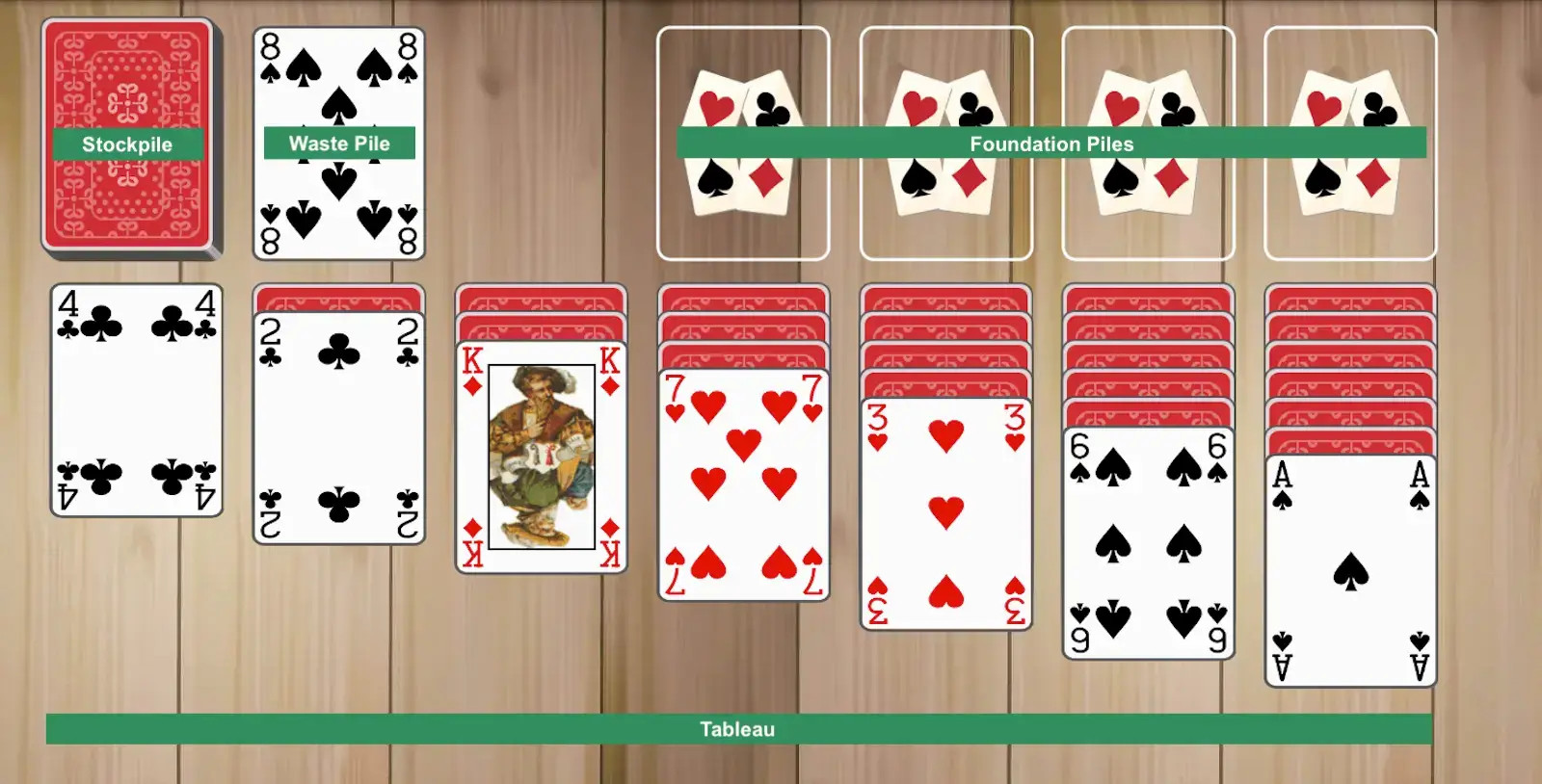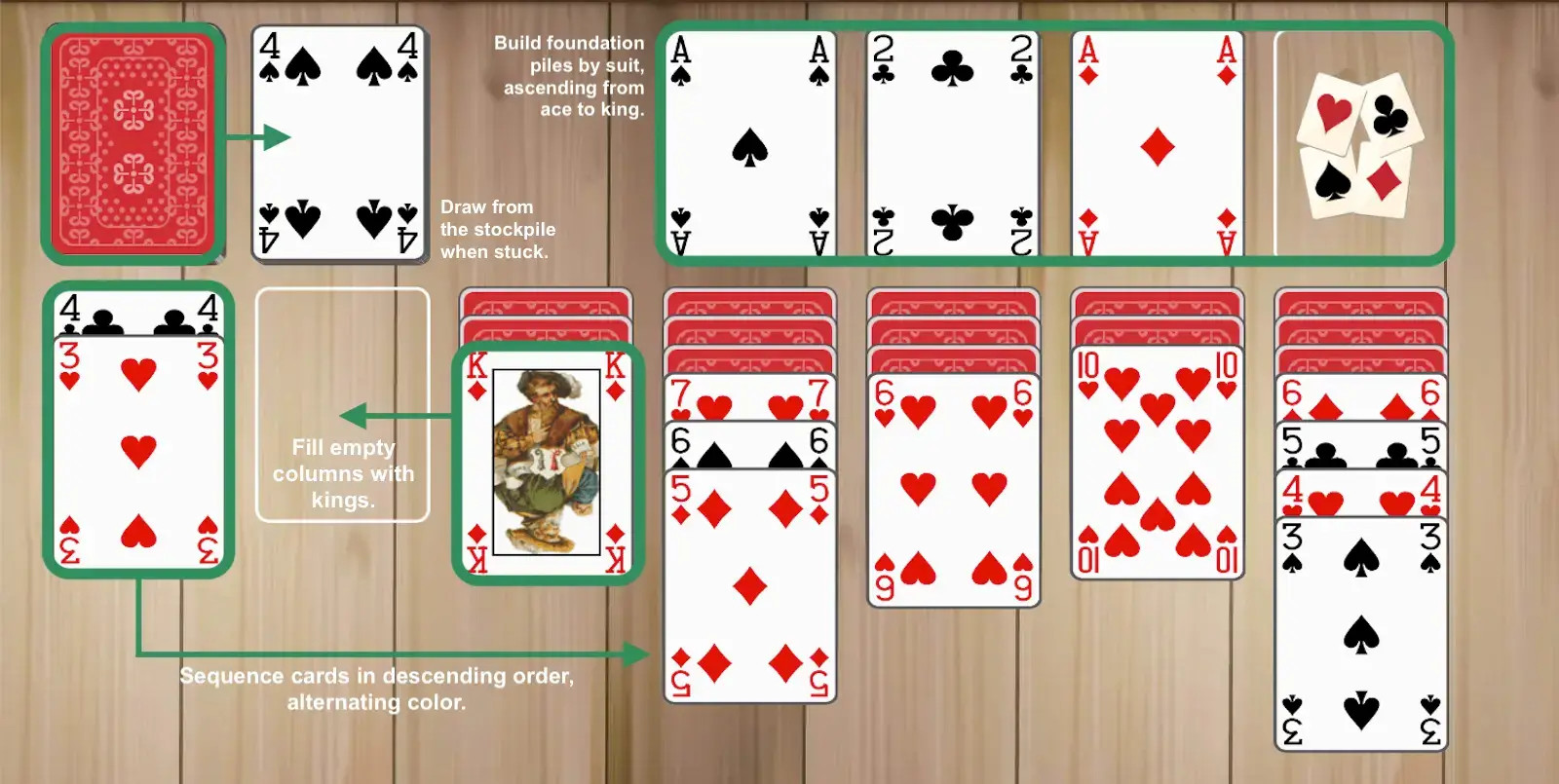Solitaire, often referred to as Klondike Solitaire or Patience, stands as the quintessential single-player card game, captivating enthusiasts for generations. The digital age has ushered in Classic Solitaire Online, making this beloved pastime more accessible than ever. Online platforms typically offer variations like Turn 1 and Turn 3, with Turn 3 presenting a greater challenge for seasoned players. Many online versions, such as those found on Solitaire Bliss, extend beyond classic Klondike, providing access to other engaging solitaire variants like FreeCell and Spider Solitaire. Furthermore, online platforms enrich the experience with customizable features including solvable-only game modes, performance statistics, unique card designs and backgrounds, and options for larger card formats for comfortable play.
Understanding the Basics of Classic Solitaire
The primary objective in classic solitaire online is straightforward yet engaging: you must maneuver all cards to four foundation piles. These piles are built by suit, in ascending order, commencing with the Ace and culminating with the King. This is achieved by strategically arranging cards within the tableau.
Solitaire Objective
The goal of classic Solitaire is to move all cards to the four foundation piles. These are built by suit, starting with Aces and ascending to Kings. Success hinges on skillfully sequencing cards within the tableau.
Solitaire Setup
Before diving into gameplay, familiarity with basic Solitaire terminology and setup is beneficial. A standard 52-card deck is used to create four key areas:
- Tableau: This is the main playing area where you arrange face-up cards and reveal face-down cards. It is composed of 28 cards distributed across seven columns. Each column’s card count corresponds to its column number, starting with one card in the first column and increasing to seven in the seventh. The topmost card in each column is dealt face up, while the rest are face down.
- Stockpile: Located at the upper-left corner, the stockpile holds the remaining 24 cards after setting up the tableau. These cards are drawn when no moves are available in the tableau.
- Waste pile: Situated next to the stockpile, the waste pile is where cards drawn from the stockpile are placed face-up. Cards in the waste pile are available to be moved to the tableau or foundation piles if a valid move exists.
- Foundation piles: These are the four piles, one for each suit (hearts, diamonds, clubs, spades), positioned above the tableau. You begin each foundation pile by placing an Ace of the corresponding suit and then build upon it in ascending order, from 2 to King.
 Solitaire set up
Solitaire set up
Mastering Gameplay: How to Play Classic Solitaire
Solitaire rules are fundamentally simple, but mastering the game requires strategic thinking and planning. It’s advisable to grasp the basic rules before exploring more intricate Solitaire variations.
Solitaire Rules
- Move Face-Up Cards Only: Initially, only the face-up cards at the bottom of each tableau column are available for moves. As the game progresses, cards from the waste pile and newly revealed tableau cards become playable. When a face-down card in the tableau is uncovered, it should be turned face up and becomes available for play.
- Sequence Cards in Descending Order and Alternating Colors: Cards in the tableau are sequenced in descending rank, alternating between red (diamonds, hearts) and black (clubs, spades) suits. For instance, a 9 of spades can be placed on a 10 of diamonds or hearts.
- Move Card Sequences as a Group: Sequences of cards arranged in descending order and alternating colors can be moved as a unit. For example, a sequence of 5 of spades, 4 of hearts, and 3 of spades can be moved together onto a 6 of diamonds or hearts.
- Utilize the Stockpile When Stuck: If no moves are possible within the tableau, draw a card from the stockpile by clicking on it. In “Turn 1” solitaire, one card is dealt at a time; in “Turn 3,” three cards are dealt, though only the top card is playable. The drawn card is placed face-up on the waste pile and can be used if a valid move is available. Once the stockpile is depleted, you can typically redeal the waste pile to form a new stockpile, although the number of redeals may be limited depending on the specific game rules or online platform.
- Fill Empty Tableau Columns with Kings: An empty column in the tableau can only be filled by a King or a sequence starting with a King. No other card ranks can initiate a new column.
- Build Foundation Piles by Suit and Rank: Foundation piles are built by suit, starting with the Ace and progressing in ascending order (Ace, 2, 3, …, Queen, King). The ultimate goal is to transfer all cards from the tableau and waste pile to the foundation piles, thus completing the game.
 Solitaire rules
Solitaire rules
Advanced Strategies to Win at Classic Solitaire Online
Having learned the basic gameplay, employing strategic approaches can significantly improve your win rate in classic solitaire online.
Solitaire Strategies
- Prioritize Tableau Moves: Before resorting to cards in the waste pile, explore and exhaust all possible moves within the tableau. This strategy maximizes the revealing of face-down cards and clearing of columns, preventing premature placement of waste pile cards that might restrict future options.
- Focus on Uncovering Face-Down Cards: Prioritize moves that lead to turning face-down cards face up. Revealing these hidden cards expands the available moves and opens up possibilities for building sequences and accessing needed cards.
- Target Longer Tableau Columns: Focus on uncovering cards in the tableau columns with more face-down cards. These columns hold a larger number of hidden cards, which are crucial for progressing through the game and unlocking more potential moves.
- Build Foundation Piles Evenly: Aim to build foundation piles relatively evenly. Allowing one foundation pile to significantly outpace others can complicate sequencing in the tableau. While cards can be moved back from foundation piles to the tableau, this incurs additional moves and should be done judiciously.
- Create Sequences Using Suit Pairs When Possible: When feasible, construct sequences in the tableau using pairs of suits (e.g., diamonds and spades, or hearts and clubs). This approach can facilitate more balanced and efficient transfer of sequences to the foundation piles later in the game.
- Anticipate Gaps in Sequences: Before moving a card from the waste pile to the tableau, assess its potential impact on future gameplay. Look for gaps in existing tableau sequences that the waste card could fill, thereby furthering progress. For instance, if a column contains a King of spades and Queen of hearts, and another column has a 10 of diamonds and 9 of spades, moving a Jack of clubs from the waste pile to the tableau is advantageous as it contributes to building a more complete sequence.
Enhance Your Game: Playing Classic Solitaire Online
Playing classic solitaire online offers numerous enhancements to the traditional card game experience. Online platforms provide a range of customization options, from personalizing card backs and designs to adjusting display settings for optimal viewing. Many platforms also automatically track game statistics, offering insights into your performance and progress.
Features commonly found in classic solitaire online include:
- Adjustable Card Size: Easily resize cards to suit your visual preference and screen size, ensuring comfortable gameplay.
- Game Saving and Loading: Save games in progress and resume them later, allowing flexibility and convenience in your play sessions.
- Background Customization: Personalize the game environment by changing the background color or pattern to match your style.
- Click-to-Move Functionality: Enable the click-to-move feature for quicker gameplay. With this option, clicking a card automatically moves it to a valid foundation or tableau pile if available. However, be mindful that relying solely on this feature might not always lead to the most strategic move. Drag-and-drop functionality remains a standard alternative for more deliberate card placement.
- Solvable Games Mode: For players who enjoy guaranteed wins, some platforms offer a “winnable games only” mode. While these games are solvable, achieving victory still requires skill and strategic thinking.
Now that you’re equipped with the knowledge of how to play classic Klondike Solitaire online, immerse yourself in the game for free and explore the myriad of other card games available online. Enjoy the challenge and the timeless appeal of solitaire!

